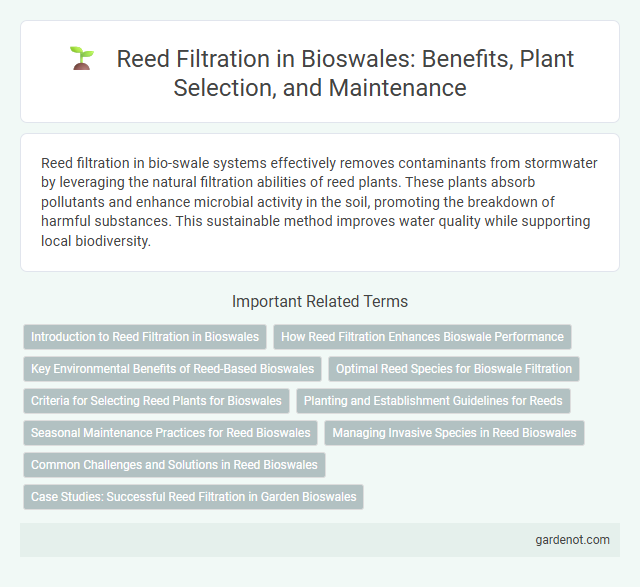Reed filtration in bio-swale systems effectively removes contaminants from stormwater by leveraging the natural filtration abilities of reed plants. These plants absorb pollutants and enhance microbial activity in the soil, promoting the breakdown of harmful substances. This sustainable method improves water quality while supporting local biodiversity.
Introduction to Reed Filtration in Bioswales
Reed filtration in bioswales utilizes dense stands of common reed (Phragmites australis) to naturally treat stormwater by trapping sediments and absorbing pollutants through root system interaction. This process enhances nutrient removal, particularly nitrogen and phosphorus, improving water quality before it infiltrates the soil. The filtration capacity of reeds supports sustainable urban drainage systems by promoting groundwater recharge and reducing contaminant loads.
How Reed Filtration Enhances Bioswale Performance
Reed filtration significantly enhances bioswale performance by improving water purification through natural processes where reeds absorb and break down pollutants, including heavy metals and nutrients. The dense root systems increase microbial activity, facilitating the biodegradation of contaminants and boosting sediment capture. This biological filtration reduces runoff toxicity, promoting healthier soil and water ecosystems within urban stormwater management.
Key Environmental Benefits of Reed-Based Bioswales
Reed-based bioswales utilize the natural filtration properties of Phragmites australis to effectively remove pollutants such as heavy metals, nitrates, and phosphates from stormwater runoff. The dense root systems of reeds enhance soil stabilization, reducing erosion and promoting groundwater recharge, while also supporting microbial communities that break down organic contaminants. This sustainable filtration process improves water quality, mitigates urban flooding, and fosters biodiversity within constructed wetlands.
Optimal Reed Species for Bioswale Filtration
Optimal reed species for bioswale filtration include Phragmites australis and Typha latifolia due to their high tolerance to varying water conditions and efficient pollutant removal capabilities. These reeds excel in nutrient uptake, sediment trapping, and contaminant degradation, enhancing bioswale performance. Selecting native reed species adapted to local climate conditions further improves filtration efficiency and biodiversity benefits.
Criteria for Selecting Reed Plants for Bioswales
Selecting reed plants for bioswales requires evaluating species based on tolerance to variable water levels, pollutant removal efficiency, and root structure effectiveness in sediment filtration. Native species such as Phragmites australis and Typha latifolia are preferred due to their adaptability to local climate and ability to thrive in wetland conditions. Emphasis on robust root systems enhances biofiltration capacity, contributing to improved stormwater management and water quality in urban landscapes.
Planting and Establishment Guidelines for Reeds
Reed filtration in bio-swales requires selecting native Phragmites australis species to ensure optimal pollutant uptake and root structure stability. Planting density should range from 4 to 6 plants per square meter to maximize filtration efficiency while preventing overcrowding. Establishment guidelines emphasize maintaining consistent moisture levels and protection from herbivory during the first growing season to promote robust rhizome development and filtration capacity.
Seasonal Maintenance Practices for Reed Bioswales
Seasonal maintenance practices for reed bioswales focus on managing vegetation growth, sediment accumulation, and water flow to maintain filtration efficiency and pollutant removal. During spring and fall, trimming reedy plants prevents overgrowth that can obstruct water movement, while periodic sediment removal ensures unimpeded infiltration and reduces clogging. Monitoring nutrient levels and adjusting water distribution promote healthy reed growth and optimize biodegradation processes essential for effective wastewater treatment.
Managing Invasive Species in Reed Bioswales
Managing invasive species in reed bioswales involves regular monitoring and selective harvesting to prevent non-native plants from outcompeting native reeds. Techniques such as manual removal and targeted herbicide application help maintain reed diversity and ecosystem function. Effective invasive species control enhances water filtration capacity and supports biodiversity in reed bioswale systems.
Common Challenges and Solutions in Reed Bioswales
Reed bioswales often face challenges such as clogging due to sediment accumulation and fluctuating water levels that stress reed growth, reducing filtration efficiency. Solutions include regular sediment removal, designing variable flow paths to prevent water stagnation, and selecting robust reed species like Phragmites australis to enhance resilience against environmental stressors. Implementing these strategies improves pollutant removal performance and extends the operational lifespan of reed filtration systems in bioswales.
Case Studies: Successful Reed Filtration in Garden Bioswales
Reed filtration in garden bioswales has proven effective in improving stormwater quality by naturally removing pollutants such as nitrogen, phosphorus, and suspended solids. Case studies from urban parks in Portland and Washington D.C. demonstrate significant reductions in runoff contaminants and enhanced groundwater recharge through the strategic planting of Phragmites australis and Typha latifolia. These projects highlight reed filtration as a sustainable, low-maintenance solution for managing urban water cycles while supporting biodiversity.
Reed filtration Infographic

 gardenot.com
gardenot.com